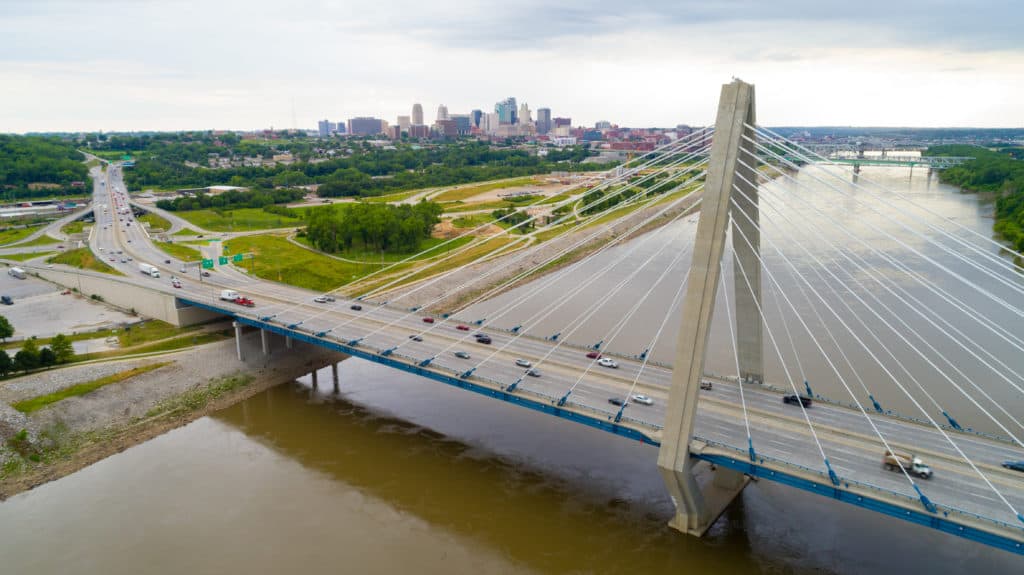As motorists travel their daily commute, they appreciate infrastructure upgrades such a freshly paved roads, smoother drives, and improved routes. However, they often don’t realize the skill, effort, and creative problem solving that goes into the construction itself.
In April 2008, Kansas City embarked upon a $245 million project that included the renovation of more than 4 miles of Interstates 29 and 35, and the construction of the Christopher S. Bond Bridge. The Bond bridge would replace the Paseo Bridge, which had spanned the Missouri River since 1954. The Missouri Department of Transportation (MoDOT) estimated that the project would require 7,000 tons of steel and 50,000 cubic yards of concrete. 3 contractors (Clarkson Construction Co., Massman Construction Co., and Kiewit Construction) formed a joint venture partnership known as Paseo Corridor Constructors (PCC) to bid on the project. The PCC partnership won the contract, and construction began in April 2008.
Bridging The Gap
In late 2009, Massman Construction, a century-old company with a reputation as one of the country’s most successful bridge builders, encountered a unique challenge during a critical portion of the new bridge. The bridge deck would be comprised of precast concrete panels, each weighing about 60,000 pounds. These panels were formed in a precast yard offsite and then transported to the bridge. Once the panels were placed, Massman was left with an 18 inch wide, 12 inch deep void that would need to be filled in with poured concrete in order to solidify and connect the bridge deck. Unfortunately, to stay on schedule, this concrete pour would have to be accomplished in the dead of a mid-west winter.
Dale Helmig, Massman project manager, said that in order for the concrete to cure properly, “we had to maintain our concrete pour at a minimum temperature of 46° F for 7 consecutive days. We were on a tight schedule and looking at outdoor temperatures at or below 0° F, we had to find a way to keep the concrete warm.” Massman contemplated concrete heating methods and realized heating the top layer of concrete was not the problem. They needed a way to protect the bottom of the fresh concrete from constant exposure to the winter elements below the bridge.
The crew decided the only way to keep the bottom layer of concrete warm, was to completely enclose it. A river barge would float underneath the bridge, hoist a plywood enclosure, and force heated air at the bottom of the bridge. This solution would be excessively expensive, time-consuming, and there was no guarantee radiant heating would be efficient enough to work.
A Powerful Solution
Fortunately, Massman connected with a local equipment dealer that had an alternative solution; electric-powered concrete curing blankets from Powerblanket. Unlike the radiant heat from the barge proposal, Powerblanket products use conduction to deliver direct, even heat.
These electric concrete blankets help cure within a desired temperature range. This seals in the concrete’s hydration reaction, and protects it from thermal cracking and surface defects.
“We gave Powerblanket’s engineers the boundary conditions we had to keep the concrete pour within — at least 46° F at the bottom but no warmer than 82° F at the top,” said Helmig. “They performed the calculations and determined the appropriate blankets needed to get the job done.” In order to heat the entire 12 inch deep slab, Powerblanket recommended our EH0612 blankets to counteract the extremely cold conditions beneath the bridge deck. For all 34 heating blankets, Powerblanket also created custom external digital thermostats so that Massman could constantly monitor their temperatures.
Pouring fresh concrete in direct contact with the freezing cold precast panels also presented a challenge. Rapid temperature change in concrete will cause it to thermally crack. To protect the structural integrity of the bridge, Powerblanket provided 6 foot x 12 foot concrete curing blankets that easily exceeded the 18 inch trough. The additional blanket width pre-heated the precast concrete panels, making it safe to pour the fresh concrete.
A Strong Finish
Massman began the week-long concrete cure, during which the outdoor air temperature hit a low of -5° F. Crew members used probes to take temperature readings several times a day. “It was awfully cold, but the blankets did their job keeping the concrete temperatures within spec,” said Helmig. “We achieved the PSI levels we had targeted, and it turned out to be a successful operation. We didn’t have the time to wait out the winter for the temperatures to become more moderate. The Powerblanket products certainly played an important role in keeping us on schedule and not having to postpone the pour.”
Helmig has since moved on to another ongoing Massman project in St. Louis, and says he may be using the blankets again there. “We were committed to doing something to stay on track,” said Helmig. “Using Powerblanket products turned out to be the fastest, simplest means of getting the job done correctly.” Work progressed so well that by late October 2010, the Christopher S. Bond Bridge had already opened to traffic crossing the Missouri River.
Thanks to partnership and ingenuity, 102,000 daily motorists can rely upon the Paseo Corridor and Christopher S. Bond Bridge. Powerblanket is proud of our part in the construction of a strong and stunning work of American infrastructure.
Cure your concrete faster and better in cold weather conditions with Powerblanket.






